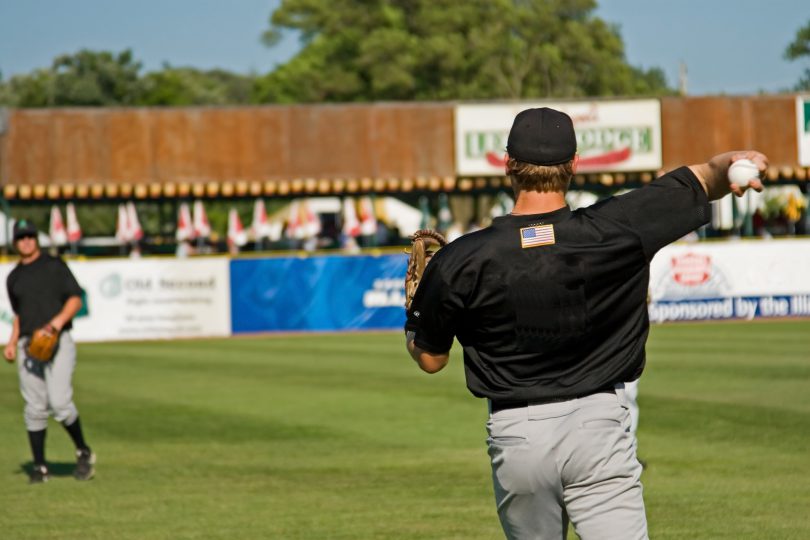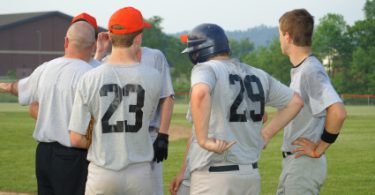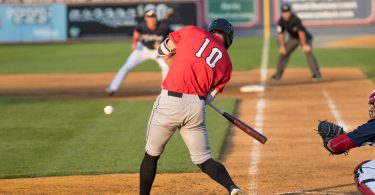We already looked at the importance of playing quality catch from a recruiter’s standpoint. If you missed it, read Quality Catch Play Part 1 to see why playing quality catch is an important way to get recruited. Now that we know college coaches are watching your catch play, how can you use it to improve your defense and overall athletic ability, in addition to showing out well? Let’s take a look at the parts of your game that you can improve by playing quality, purposeful catch each day and how to do it.
Mentality
What to do: Catch the ball every time. Don’t ever drop it.
How: Think of Remember the Titans when Coach Boone says, “Drop the ball, run a mile.” This is how you should think about handling the ball during catch play. Too often, overthrows, dropped balls, etc. are brushed aside. Sometimes, players even have extra balls ready in case they make a bad throw. It is called catch for a reason, and your number one job is to move your feet and make sure you catch every receivable throw every time. Don’t allow yourself to fumble and drop the ball at any point. Most drops are caused by lack of focus, fatigue, carelessness, or other correctable reasons. If you start making ball handling a priority every day, it will translate to the game. NO DROPS ALLOWED!
Body Movement
What to do: Make the ball be where you want it to be.
How: Watch the ball out of your partners hand and adjust to it accordingly. Good players get their body in the position they need so that the ball is where they want it to be for whatever they may be doing next (transfer for a throw, make a tag, or simply catch the ball for an out). Most of the incoming balls should be caught chest high on your throwing arm side and transferred to your throwing hand as quickly and efficiently as possible. If you try to do this every throw, you will improve your reaction time and be able to adjust to the ball better in games. Subtle, small, controlled movements make a world of difference in keeping you athletic and ready to make the next movement. Making the ball be where you want starts with a plan, your eyes, and your feet.
Hands
What to do: Present your glove to the incoming ball well every time
How: Make sure the pocket of your glove is open to the ball as it is being received. You want the most margin of error possible and ability to adjust at the last second when needed. Don’t follow the ball to the spot and get there at the last second, beat the ball there with good glove presentation. Avoid catching the ball in poor positions to transfer from, unless you are specifically working on that part of your game. Glove presentation is often taken for granted, but it goes hand-in-hand with making the ball be where you want it to be and working on the transfer. Pay attention to the position of your glove and work to be as efficient as possible. Glove fingers straight up, mouth of the glove open big, receiving the ball into the part of the glove you want. Work with your glove out in front of your body as the throw is incoming so you do not get handcuffed.
What to do: Stop the ball at impact
How: Stopping the ball or controlling the ball is a huge part of defense. It means that once the ball hits your glove in the part of the glove desired, it doesn’t move your hand, or carry your glove, unless that’s the intention. Controlling the ball allows you to transfer more quickly, give the umpire a clear look at when and where the ball is received, and generally puts the fielder in control. You will find that if you catch the ball in the appropriate part of your glove (in the pocket, with the pad of your index and middle finger behind the ball), you likely shouldn’t close your glove at all on a transfer. Most of baseball is about stopping a moving ball as quickly as possible and accelerating it to the next player. Closing your glove takes unnecessary time.
What to do: Transfer the ball quickly and with simple, short movements
How: If you are making the ball be where you want it to be (chest high and slightly on your arm side), presenting your glove well, and stopping the ball on impact, the transfer becomes a much more simple process because most of the work is done pre-catch. The transfer ideally takes place at the chest with the ball being received glove fingers up. Once you have put your body in the appropriate position and the ball is controlled, the glove moves fingers up making a ¼ turn opening up to the throwing hand. Practicing transfers at full speed are hugely important. Resist the temptation to get big with your movements as you speed up. The quickest way to transfer any received ball is a straight line from where the ball is received to your throwing hand which should stay within the frame of the body, ideally around the midline. One common mistake is to take the glove in an arc and create the exchange/transfer lower than the point it was received. The transfer and exchange should be as straight a line as possible. Keep it simple and efficient. You should also take reps catching the ball in less than ideal positions and making the transfer. This is likely to happen naturally during catch play, but can be done deliberately as well to ensure you are covering the range of exchanges you will be expected to make in game play.
Throwing
What to do: Understand the story of the throw
How: By paying attention, having a plan, and watching your and your partner’s throw. Have a plan for each throw. Execute each throw. Observe what happens. Determine the adjustments that need to be made for your next attempt. Make the adjustment, and repeat. Most simply, have a goal/plan (throw to a small target), make your throw, observe the throw, analyze and make needed adjustments, and repeat the process over-and-over. We’ll go into more specific details below.
What to do: Work on your rate of spin and axis of spin
How: If you are throwing to a specific target with a specific purpose, every throw gives you feedback. Some of the most overlooked feedback in catch play is the spin or rotation of the ball and movement of the ball. The axis or direction of your spin will tell you a lot about what you are doing mechanically. Work on generating good backspin on your throws from start to finish. Watch the direction of the spin. Is it doing what it normally does? Does it change when you are tired or sore? If it does, this is a good indication you are doing something different mechanically. If your ball is not spinning a lot, it is also a sign that your throwing motion is stiff and being dominated by the big muscles. Spinning the ball on short throws as well as long will ensure you are creating touch on your throws and using your wrist, hand, and fingers to help generate velocity and whip. Consistent spin= Consistent delivery. More spin with the appropriate spin access is a good thing.
What to do: Aim small
How: Pick out a small target to throw to. Move the target around so that you are working on throwing to different spots. Having a specific target allows you to get feedback and correct from throw-to-throw. Here’s an example of why it’s important to aim small. If you are throwing at your throwing partner and miss by 8 inches, you are still in the vicinity of your throwing partner and learn nothing. If you are throwing to the 2 inch logo on your partner’s chest and miss by 8 inches, this is a miss you can quantify/qualify and learn from. When you aim small, you are more likely to stay focused, learn, and ultimately miss smaller.
Feet
What to do: Catch and throw with your feet
How: We don’t mean you should literally catch and throw with your feet (although that would be quite a sight), but quality catch starts with and ends with the feet. In order to play quality catch, you need to be willing to move around, adjust to the ball, and generate power from the ground up. There is no place for standing flat footed or having lazy feet when receiving or making a throw. Many of the suggestions above address the need to move your feet while on the receiving end. Here we will focus on footwork while throwing. Staying between your feet, using your legs to translate ground force into velocity are key components to becoming a better and more efficient thrower. Pay attention to the direction of your stride, making sure your feet are underneath you and stable. ALWAYS PLAY CATCH IN CLEATS when you can. Momentum and direction start with your feet, cleats allow you to push off the ground more efficiently and land more stable. The more sore or tired your arm is, the more you should be using your feet and legs to generate power. The farther back you go, the more you need to be using your feet and legs to generate power. Pay attention to the stability of your front leg, which should be bracing on impact and redirecting energy from the ground back into the ball. Strong, stable legs mean strong, stable throws.
Position Specific Movements/Throws
What to do: Make position specific throws and movements part of your catch routine
How: We have written on position specific catch play in the past, and we suggest you check out those articles. This is pretty self-explanatory. Each position has different types of throws and skills that need to be mastered and that players will be expected to make during game play. Outfield long hops, catcher pops, speed pickups, etc. To use the example of an infielder, work on double play turns. Work on throwing on the run. Simulate a backhand or another type of fielding play and make the transfer and throw. Play quick catch. The list goes on-and-on for each position. Practice what you need to be good at regularly.
By improving in these 6 areas of catch play, you are sure to improve defensively without having to invest more time out of your practice plan. Every throw is an opportunity to get better. Don’t delay, get started on it today!







